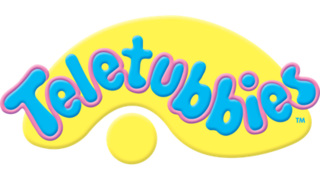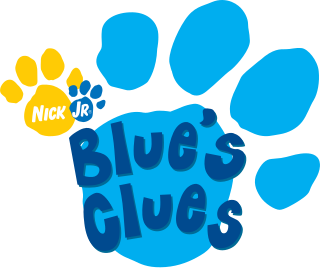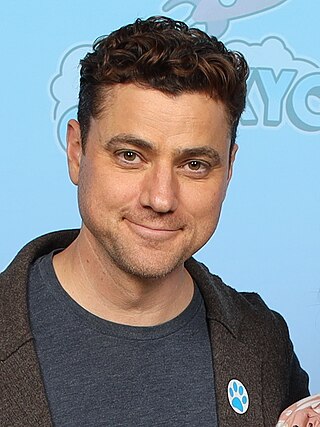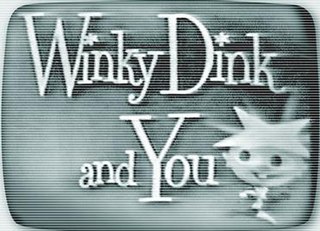Related Research Articles

Teletubbies is a British children's television series created by Anne Wood and Andrew Davenport for the BBC. The programme focuses on four differently coloured characters known as the Teletubbies, named after the television screens on their bellies. Recognised throughout popular culture for the uniquely shaped antenna protruding from the head of each character, the Teletubbies communicate through gibberish and were designed to bear resemblance to toddlers.

Sesame Street is an American educational children's television series that combines live-action, sketch comedy, animation and puppetry. It is produced by Sesame Workshop and was created by Joan Ganz Cooney and Lloyd Morrisett. It is known for its images communicated through the use of Jim Henson's Muppets, and includes short films, with humor and cultural references. It premiered on November 10, 1969, to positive reviews, some controversy, and high viewership. It has aired on the United States national public television provider PBS since its debut, with its first run moving to premium channel HBO on January 16, 2016, then its sister streaming service HBO Max in 2020.

Children's television series are television programs designed specifically for children. They are typically characterised by easy-going content devoid of sensitive or adult-facing themes and are normally scheduled for broadcast during the morning and afternoon when children are awake, immediately before and after school schedules generally start country-by-country. Educational themes are also prevalent, as well as the transmission of cautionary tales and narratives which teach problem-solving methods in some fashion or another, such as social disputes.

Interactive television is a form of media convergence, adding data services to traditional television technology. It has included on-demand delivery of content, online shopping, and viewer polls. Interactive TV is an example of how new information technology can be integrated vertically into established technologies and commercial structures.

Blue's Clues is an American live-action/animated interactive educational children's television series, created by Angela C. Santomero, Todd Kessler, and Traci Paige Johnson, that premiered on Nickelodeon's Nick Jr. block on September 8, 1996, and concluded its run on August 6, 2006, with a total of six seasons and 143 episodes. The original host of the show was Steve Burns, who left in 2002 and was replaced by Donovan Patton for the rest of the series. The show follows an animated blue-spotted dog named Blue as she leaves a trail of clues/paw prints for the host and the viewers to figure out her plans for the day.

BBC Children's and Education is the BBC division responsible for media content for children in the UK. Since the launch of specially dedicated television channels in 2002, the services have been marketed under two brands. CBBC is aimed at children aged between 6 and 12, and CBeebies offers content for younger viewers.
Elmo's World is a segment that is shown at the end of the American children's television program Sesame Street which premiered on November 16, 1998, as part of a broader structural change to the show. It originally lasted fifteen minutes at the end of each episode. The segment ran until 2009, and then returned in 2017. The segment was designed to appeal to younger viewers and to increase ratings, which had fallen in the past decade. The segment is presented from the perspective of a three-year-old child as represented by its host, the Muppet Elmo, performed by Kevin Clash in the original series and Ryan Dillon in the 2017 reboot.

Donovan Patton is an American actor and television host. Patton graduated from the Interlochen Arts Academy and acted in Shakespeare plays such as Much Ado About Nothing and Romeo and Juliet before replacing Steve Burns as the host of Nickelodeon's long-running children's television program, Blue's Clues in 2002. Series co-creator Angela Santomero stated that Patton brought Joe, his character, closer to the preschool viewer, as Joe was more willing to "jump into a problem rather than figuring it out first like Steve". After Blue's Clues ended in 2006, Patton then voiced Bot on Nickelodeon's Team Umizoomi (2010–2015) and currently voices CatRat on the Netflix original DreamWorks series Gabby's Dollhouse as well as special appearances in the new series Blue's Clues & You!.

Winky Dink and You was a CBS children's television show that aired from 1953 to 1957, on Saturday mornings at 10:30 a.m. Eastern / 9:30 Central. It was hosted by Jack Barry and featured the exploits of a cartoon character named Winky Dink and his dog Woofer, with sound effects provided by Joseph Scholnick. The show, created by Harry Prichett, Sr. and Ed Wyckoff, featured Barry and his sidekick, the incompetent Mr. Bungle, introducing clips of Winky Dink, who was noted for his plaid pants, tousled star-shaped hair, and large eyes.
Todd Kessler is an American film and television writer, producer and director. Among his credits are showrunner and co-creator of Nickelodeon's preschool series Blue's Clues and director and producer of the feature film Keith (2008).

QUBE was a former experimental two-way, multi-programmed cable television system that played a significant role in the history of American interactive television. It was launched in Columbus, Ohio, on 1 December 1977. Highly publicized as a revolutionary advancement, the QUBE experiment introduced viewers to several concepts that became central to the future development of TV technology: pay-per-view programs, special-interest cable television networks, and interactive services. It went defunct in 1984.
MYtv provides satellite pay-TV services throughout Ukraine.

Blue's Big Musical Movie is a 2000 American direct-to-video live-action/animated musical film. It is the first installment of the Blue's Clues film series and based on the original television series on Nickelodeon's Nick Jr. block. It was released on VHS and DVD on October 3, 2000. The movie also aired on television, starting with a primetime premiere on January 13, 2002. This movie was reissued on DVD along with Dora the Explorer: Musical School Days on July 23, 2013. A video game based on the film was released for the PlayStation around the same time, making it the only Blue's Clues video game on a home console other than the V.Smile. A standalone sequel, Blue's Big City Adventure was released on November 18, 2022.
The children's television show Sesame Street, which premiered on public broadcasting television stations in 1969, was the first show of its kind that utilized a detailed and comprehensive educational curriculum, with specific educational goals, in its content. Its goals were garnered from in-house formative research and independent summative evaluations, and its first curriculum was created in a series of five seminars in 1968.
A second screen involves the use of a computing device to provide a different viewing experience for content on another device.

Angela C. Santomero is an American television executive producer and co-creator of the Nickelodeon children's television programs Blue's Clues, its spin-off Blue's Room, and its reboot Blue's Clues & You!, as well as the PBS children's shows Super Why!, & Daniel Tiger's Neighborhood the Amazon Studios series Creative Galaxy, Wishenpoof!, and the Netflix original series Charlie's Colorforms City. Santomero has won a Peabody Award, a 2012 Emmy Award for Daniel Tiger's Neighborhood, two Television Critics Association Awards, and the 2018 World Screen's Kids Trendsetter Award. She has been nominated for more than twenty-five Emmy Awards and numerous Parents' Choice Gold and Silver Awards.

Traci Paige Johnson is an American animator and voice actress best known for creating the Nick Jr. Channel television series, Blue's Clues (1996–2006), its spin-off, Blue's Room (2004–2007), and the reboot series, Blue's Clues & You! (2019–present). She voices the titular character for the original series and & You!.
Event television is a television network marketing concept which arose in the early 2010s and is characterized by a shift in priorities towards enticing audiences to watch programming immediately as it is broadcast. This is largely in response to the tendency of modern audiences to time shift programming (DVR) or view using on-demand streaming services, which has produced a steady decline in live viewership ratings.

America Goes Bananaz is a teenager-oriented variety show presented by Michael Young and Randy Hamilton. It premiered locally on QUBE's C-1 channel in 1977, with the title Columbus Goes Bananaz. The series was renamed America Goes Bananaz in preparation for a move to then-upcoming youth-oriented national network Nickelodeon; all episodes aired from January 19, 1979, onward used this title.
Participatory cues are overt actions by on-screen characters prompting a reaction from a viewing audience. Specifically, participatory cues are defined as when characters "break the fourth wall, the imaginary wall at the front of the stage, by asking children to respond to queries and build in pauses to allow children time to respond to these queries".
References
- ↑ Carter, Elizabeth J.; Hyde, Jennifer; Hodgins, Jessica K. (27 June 2017). "Investigating the Effects of Interactive Features for Preschool Television Programming". Proceedings of the 2017 Conference on Interaction Design and Children. pp. 97–106. doi:10.1145/3078072.3079717. ISBN 9781450349215. S2CID 21080931 . Retrieved 22 January 2022.
- ↑ Bob Greene (March 31, 2013). "Winky Dink and ... Bill Gates?". CNN . Retrieved March 27, 2018.
- ↑ Schmelzer, Randi (6 August 2006). "Tale of the Pup: Innovative Skein Leads Way to Preschool TV boom". Variety. Retrieved 6 June 2021.
- ↑ Crawley, Alisha M.;Daniel R. Anderson; Angela Santomero; Alice Wilder; Marsha Williams; Marie K. Evans; Jennings Bryant (June 2002). "Do Children Learn How to Watch Television? The Impact of Extensive Experience With Blue's Clues on Preschool Children's Television Viewing Behavior". Journal of Communication52 (2): 264–280. doi : 10.1111/j.1460-2466.2002.tb02544.x
- ↑ Anderson, Daniel R. (2004). "Watching Children Watch Television and the Creation of Blue's Clues". In Hendershot, Heather (ed.). Nickelodeon Nation: The History, Politics, and Economics for America's Only TV Channel for Kids. New York: New York University Press. ISBN 978-0-8147-3651-7.